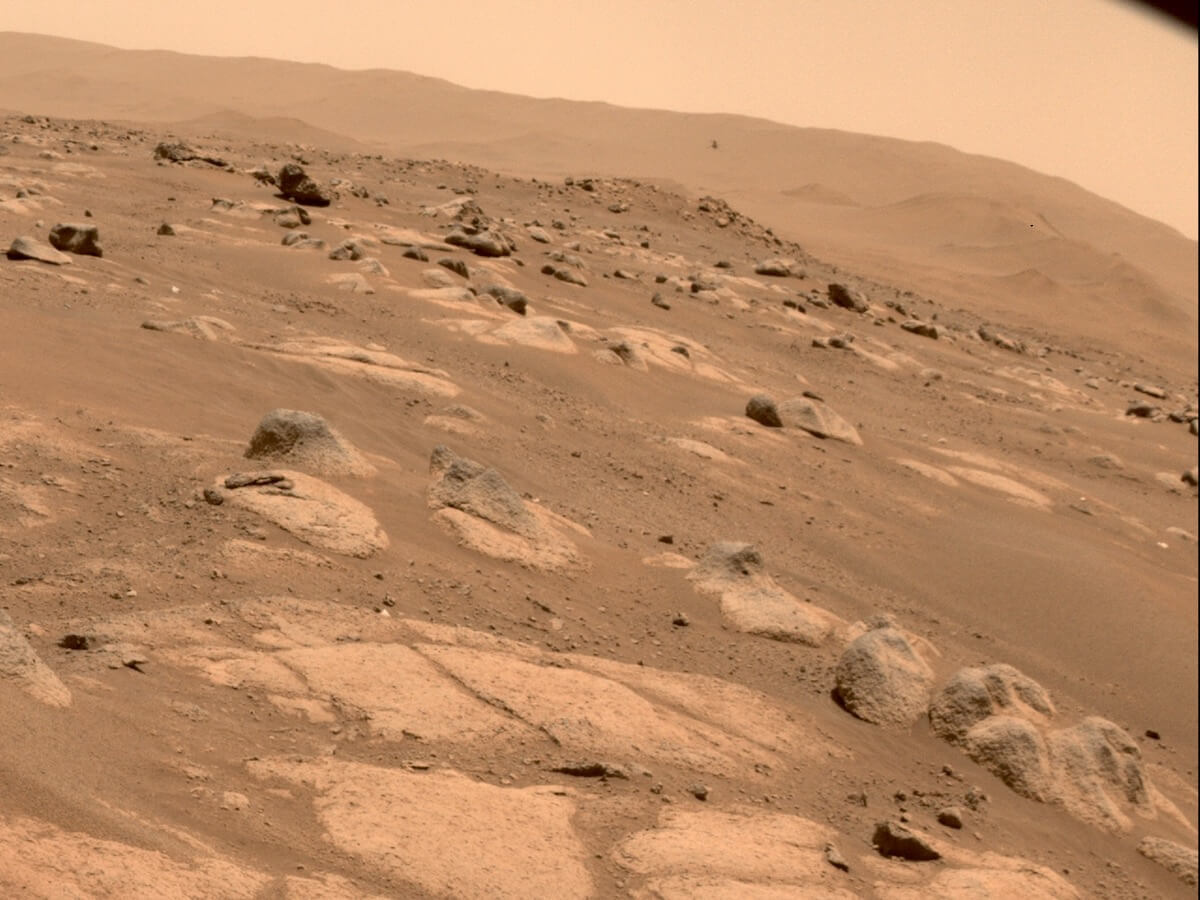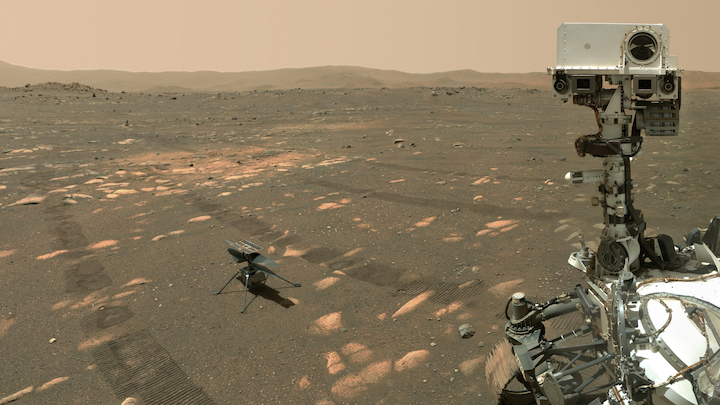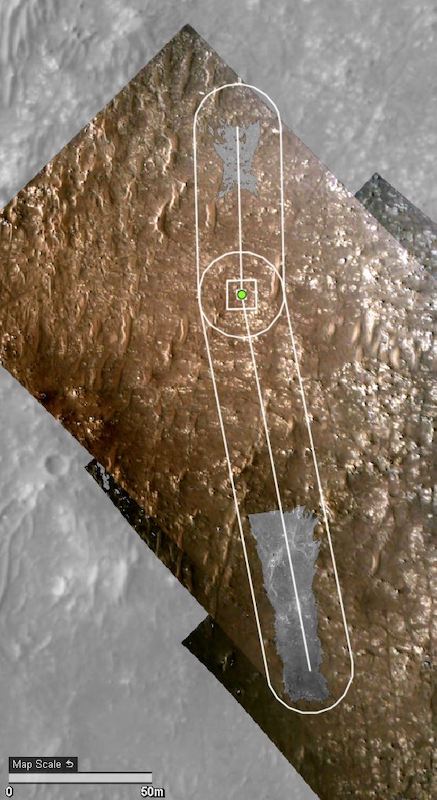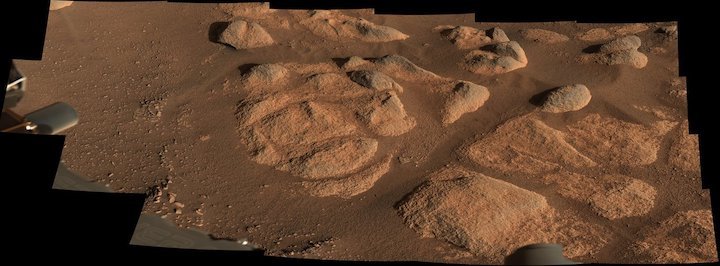4.05.2021
Ingenuity: mission extended
So successful is tiny Mars helicopter Ingenuity that NASA’s decided to extend its mission.

NASA’s Ingenuity Mars helicopter worked so well on its initial test flights that NASA has decided to extend its mission another 30 sols (Mars days).
But instead of simply testing the helicopter, says Lori Glaze, director of NASA’s Planetary Science Division, it will be seeing how it can be used to help explore the Martian landscape in tandem with the Perseverance rover.
“It’s going to transition from a technology demonstration to an operations demonstration,” she says.
“It’s a new phase,” says the helicopter’s project manager, MiMi Aung of NASA’s Jet Propulsion Laboratory, in California.
Initially, Aung says, the goal was simply to demonstrate that it was possible to fly on Mars, and then to investigate how flying Ingenuity on Mars differed from flying it in the lab – important information for the development of the next generation of Mars helicopters. In the process, she expected that the helicopter would be pushed close enough to its limits that its last flight of the month was likely to be a crash.
But it turned out that there were precious few differences between flying on Mars and the engineers’ expectations.
In its first three flights, the helicopter demonstrated that it could rise, hover, fly, track its elevation to within a centimetre, and land safely at precisely the designated position. “All in all, it’s really a great-performing vehicle,” says Bob Balaram, the helicopter’s chief engineer.
What that means is that the Perseverance rover team is suddenly gifted with a functional helicopter that might actually be able to carry out aerial reconnaissance.
To test that, the helicopter’s fourth flight last Saturday (AEDT) saw it airborne for 117 seconds, flying 133 metres out and back, and taking about 60 black-and-white and 5 colour images along the way.
These, Aung says, will be used to make 3D maps of the surrounding terrain—maps that can be used to find another safe landing zone for the fifth flight.
“All in all, it’s really a great-performing vehicle,” says Bob Balaram, the helicopter’s chief engineer.
That flight will be a one-way trip to the new “airfield,” demonstrating that the helicopter can scout out its own landing zone on one flight, then go to it on the next, leaping across the Martian surface, rather than staying at a single base.
Meanwhile, says Jenifer Trosper, the rover’s deputy project manager, the Perseverance rover itself will go back to its main mission, to study Jezero Crater and collect samples for eventual return to Earth.
Previously, she says, scientists had thought that this was the point where Ingenuity would have to be abandoned, even if it hadn’t crashed.
That’s because the helicopter can only fly for 2 minutes per outing, before it has to land, lest its motor overheat, says Balaram. And because it’s solar powered, it has to recharge its batteries. It wasn’t expected to take long for the rover to outdistance it and lose contact.
But, says Trosper, it turns out that the rover won’t be driving very far in the next few weeks.
“We thought we would be driving away from the region we landed,” she says, “but the sample team is interested in getting the [first] samples from this region.”
That area, says Ken Farley, a project scientist at California Institute of Technology (Caltech), is a narrow strip about 1.6km long that appears to contain ancient mudstones.
These are formed from what was once silt at the bottom of the lake that once filled the crater, coming from a time when the lake would have been particularly habitable. They are also the type of sediment that is most likely to preserve signatures of ancient life, he says. “[So] we are planning to explore this area looking for interesting rocks.”
Will Ingenuity be able to help find the best sample sites? Time will tell.
Meanwhile, Farley says, “we appreciate the [helicopter’s] scouting ability and the ability to fly to territory the rover could not traverse. This is useful for future missions that could combine a rover with a helicopter.”
With flight number four logged, however, the helicopter team will have to slow down the pace of its operations.
For the past month, the rover’s main job has been to babysit the helicopter, taking pictures of it as it flies, and limiting its own activities to minimize the risk of electrical interference with the helicopter’s signals.
Now, the helicopter takes a backseat, and will only fly when it doesn’t distract from the rover’s main mission.
“We will fly every few weeks instead of every few sols,” Trosper says.
After 30 sols, the new phase of the helicopter’s mission will be re-evaluated, and possibly extended again.
“Right now it’s healthy,” Balaram says. “But it wasn’t designed for a long mission and its components haven’t been tested for how many cold Martian nights they can tolerate before something snaps.” But he says, “there are no consumables on this helicopter. The only consumable is our landing gear, which is good for up to 100 landings”.
All told, Glaze says, this is a “see how it goes” phase of the mission. “There is the potential to go beyond [30 days] but we’ll have to assess after 30 days.”
Not to mention that there is still the risk of a crash. “We are transferring to airfields that are not well characterised,” Aung says, “so there is higher possibility of errant landings.”
Quelle: COSMOS
----
Update: 5.05.2021
.
NASA Extends Mars Helicopter Mission, Will Scout for Perseverance Rover
Ingenuity will keep flying, but things are going to get more challenging

Image: NASA/JPL-Caltech/MSSS
The Ingenuity Mars Helicopter has been doing an amazing job flying on Mars. Over the last several weeks it has far surpassed its original goal of proving that flight on Mars was simply possible, and is now showing how such flights are not only practical but also useful.
To that end, NASA has decided that the little helicopter deserves to not freeze to death quite so soon, and the agency has extended its mission for at least another month, giving it the opportunity to scout a new landing site to keep up with Perseverance as the rover starts its own science mission.
Some quick context: the Mars Helicopter mission was originally scheduled to last 30 days, and we’re currently a few weeks into that. The helicopter has flown successfully four times; the most recent flight was on April 30, and was a 266 meter round-trip at 5 meters altitude that took 117 seconds. Everything has worked nearly flawlessly, with (as far as we know) the only hiccup being a minor software bug that has a small chance of preventing the helicopter from entering flight mode. This bug has kicked in once, but JPL just tried doing the flight again, and then everything was fine.
In a press conference last week, NASA characterized Ingenuity’s technical performance as “exceeding all expectations,” and the helicopter met all of its technical goals (and then some) earlier than anyone expected. Originally, that wouldn’t have made a difference, and Perseverance would have driven off and left Ingenuity behind no matter how well it was performing. But some things have changed, allowing Ingenuity to transition from a tech demo into an extended operational demo, as Jennifer Trosper, Perseverance deputy project manager, explained:
“We had not originally planned to do this operational demo with the helicopter, but two things have happened that have enabled us to do it. The first thing is that originally, we thought that we’d be driving away from the location that we landed at, but the [Perseverance] science team is actually really interested in getting initial samples from this region that we’re in right now. Another thing that happened is that the helicopter is operating in a fantastic way. The communications link is overperforming, and even if we move farther away, we believe that the rover and the helicopter will still have strong communications, and we’ll be able to continue the operational demo.”
The communications link was one of the original reasons why Perseverance’s mission was going to be capped at 30 days. It’s a little bit counter-intuitive, but it turns out that the helicopter simply cannot keep up with the rover, which Ingenuity relies on for communication with Earth. Ingenuity is obviously faster in flight, but once you factor in recharge time, if the rover is driving a substantial distance, the helicopter would not be able to stay within communications range.
And there’s another issue with the communications link: as a tech demo, Ingenuity’s communication system wasn’t tested to make sure that it can’t be disrupted by electronic interference generated by other bits and pieces of the Perseverance rover. Consequently, Ingenuity’s 30-day mission was planned such that when the helicopter was in the air, Perseverance was perfectly stationary. This is why we don’t have video where Perseverance pans its cameras to follow the helicopter—using those actuators might have disrupted the communications link.
Going forward, Perseverance will be the priority, not Ingenuity. The helicopter will have to do its best to stay in contact with the rover as it starts focusing on its own science mission. Ingenuity will have to stay in range (within a kilometer or so) and communicate when it can, even if the rover is busy doing other stuff. This extended mission will initially last 30 more days, and if it turns out that Ingenuity can’t do what it needs to do without needing more from Perseverance, well, that’ll be the end of the Mars helicopter mission. Even best case, it sounds like we won’t be getting any more pictures of Ingenuity in flight, since planning that kind of stuff took up a lot of the rover’s time.
With all that in mind, here’s what NASA says we should be expecting:
“With short drives expected for Perseverance in the near term, Ingenuity may execute flights that land near the rover’s current location or its next anticipated parking spot. The helicopter can use these opportunities to perform aerial observations of rover science targets, potential rover routes, and inaccessible features while also capturing stereo images for digital elevation maps. The lessons learned from these efforts will provide significant benefit to future mission planners. These scouting flights are a bonus and not a requirement for Perseverance to complete its science mission.
The cadence of flights during Ingenuity’s operations demonstration phase will slow from once every few days to about once every two or three weeks, and the forays will be scheduled to avoid interfering with Perseverance’s science operations. The team will assess flight operations after 30 sols and will complete flight operations no later than the end of August.”
Specifically, Ingenuity spent its recent Flight 4 scouting for a new airfield to land at, and Flight 5 will be the first flight of this new operations phase, where it’ll attempt to land at this new airfield, a place it’s never touched down before about 60m south of its current position on Mars. NASA expects that there might be one or two flights after this, but nobody’s quite sure how it’s going to go, and NASA wasn’t willing to speculate about what’ll happen longer term.
It’s important to remember that all of this is happening in the context of Ingenuity being a 30 day tech demo. The hardware on the helicopter was designed with that length of time in mind, and not a multi-month mission. NASA said during their press conference that the landing gear is probably good for at least 100 landings, and the solar panel and sun angle will be able to meet energy requirements for at least a few months. The expectation is that with enough day/night thermal cycles, a solder joint will snap, rendering Ingenuity inoperable in some way. Nobody knows when that’ll happen, but again, this is a piece of hardware designed to function for 30 days, and despite JPL’s legacy of ridiculously long-loved robotic explorers, we should adjust our expectations accordingly. MiMi Aung, Mars Helicopter Project Manager, has it exactly right when she says that “we will be celebrating each day that Ingenuity survives and operates beyond that original window.” We’re just glad that there will be more to celebrate going forward.
Quelle: IEEE
----
Update: 9.05.2021
.
NASA Mars helicopter heard humming through planet's thin air
NASA is sharing sounds of its little helicopter humming through the thin Martian air






